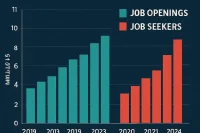The Dramatic Convenience Store Transformation Reshaping a Global Giant
The convenience store transformation happening at 7-Eleven represents one of the most fascinating business evolution stories in retail today. With 62 million daily visitors—more than the combined population of California and New York—7-Eleven has grown from a simple Dallas ice vendor into the world’s largest convenience store chain, boasting 85,000 locations globally (surpassing both Starbucks and McDonald’s combined).
At the heart of this expansion is a remarkable convenience store transformation that began when Japanese retailer Ito Yokado discovered the American brand in the 1970s, eventually acquiring full ownership by 2005 under the holding company Seven & i. This cross-cultural business exchange revolutionized what convenience stores could offer consumers.
Japan’s “Gourmet Convenience” Revolution
In Japan, 7-Eleven perfected what could be called “gourmet convenience”—fresh fruit smoothies, high-quality sandwiches, onigiris (rice balls), and bento boxes that rival restaurant offerings. This stands in sharp contrast to the typical American convenience store experience centered around processed foods like hot dogs, burgers, and slushies.
The Japanese convenience store transformation extends beyond food to services. Customers can handle banking, ship packages, pay municipal bills, and access numerous social services—making these stores essential community hubs rather than mere snack stops.

The Secret Behind Japan’s Convenience Store Transformation Success
The remarkable efficiency of Japanese 7-Eleven locations stems from their innovative “Tanpin Kanri” inventory management system—a model so effective it’s been the subject of Harvard Business School case studies.
This automated supply chain tracks real-time purchasing patterns, intelligently predicting stock needs across different locations. The system coordinates deliveries from over 150 dedicated factories that produce 7-Eleven-exclusive products daily.
The Global Expansion Challenge
Despite its Japanese success, replicating this convenience store transformation internationally has proven challenging:
- Geographic differences: America’s vast size makes the dense distribution network crucial to Japan’s fresh food model difficult to implement
- Consumer preferences: Processed foods comprise 47% of U.S. sales—nearly double Japan’s rate
- Economic pressures: Inflation-conscious American consumers increasingly bypass convenience stores for discount retailers and bulk purchases
This has created significant headwinds for 7-Eleven’s North American operations, which account for approximately half of the company’s profit.
Hiring Retail Management Talent?
Post retail and customer service leadership positions to find professionals who understand convenience store transformation
The Billion-Dollar Battle for Convenience Store Transformation
Enter Quebec-based Alimentation Couche-Tard, owner of Circle K stores, with its bold takeover bid for Seven & i Holdings. If successful, this would create the world’s dominant convenience store empire and mark the largest foreign acquisition of a Japanese company in history.
The strategic rationale is clear: Couche-Tard wants to leverage 7-Eleven’s expertise and vast store network while potentially bringing more standardized global retail practices to the operation.
Why This Matters for Retail’s Future
This potential merger represents a pivotal moment in the convenience store transformation happening globally:
- It demonstrates the increasing consolidation within retail as companies seek economies of scale
- It highlights the importance of operational expertise in creating competitive advantage
- It raises questions about maintaining cultural aspects of retail experiences across borders
- It could accelerate innovation in convenience retailing worldwide
Looking to understand how retail transformation affects job markets? Check out our latest retail employment trends report for insights on career opportunities.
Need Career Guidance?
Get expert advice on navigating careers during this convenience store transformation era
Cultural Identity vs. Global Standardization
Despite 7-Eleven’s American origins, it has evolved into a cultural institution in Japan. The potential foreign takeover raises important questions about preserving the “magical” shopping experience Japanese 7-Eleven stores have cultivated.
According to retail experts, the unique atmosphere of discovery and excitement in Japanese 7-Eleven locations represents exactly what both investors and Couche-Tard are pursuing—a retail experience that transcends mere transaction.
The outcome of this corporate battle could determine whether the remarkable convenience store transformation pioneered in Japan can successfully blend with Western retail practices to create a truly global model, or whether regional differences will continue to define the convenience experience.
Interested in exploring careers in this evolving industry? Search thousands of retail and service positions on WhatJobs that match your skills and interests.
FAQ About Convenience Store Transformation
What factors are driving the current convenience store transformation?
The convenience store transformation is being propelled by several key factors including changing consumer preferences toward fresher food options, demand for more integrated services beyond retail, supply chain innovations enabling better inventory management, and increasing competition from other retail formats like grocery stores and quick-service restaurants. These pressures are forcing convenience retailers to reimagine their value proposition.
How does 7-Eleven’s approach to convenience store transformation differ between Japan and the US?
In Japan, the convenience store transformation at 7-Eleven focuses on fresh food production, with hot and pre-packaged fresh items comprising a significantly larger portion of sales than in the US. Japanese stores also offer extensive services (banking, shipping, bill payment) and utilize the Tanpin Kanri automated inventory system. In contrast, US stores rely more heavily on processed foods (47% of sales) and face greater logistical challenges due to geographic distribution.
What potential impacts would the Couche-Tard takeover have on the convenience store transformation?
If successful, Couche-Tard’s acquisition of Seven & i Holdings could accelerate the global convenience store transformation by combining Circle K’s standardized international practices with 7-Eleven’s operational expertise and dense store network. This could potentially lead to improvements in supply chain efficiency, product offerings, and service integration across markets, though cultural differences may present challenges to maintaining the distinctive customer experience of Japanese 7-Eleven locations.
Why has 7-Eleven’s convenience store transformation been difficult to replicate globally?
The convenience store transformation that made 7-Eleven successful in Japan has been challenging to replicate globally due to several factors: differences in distribution networks and population density that affect fresh food delivery logistics, varying consumer preferences across markets, diverse regulatory environments affecting services offered, and different operational models (direct ownership vs. franchising vs. licensing) that complicate standardization of the customer experience across countries.




